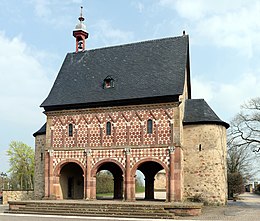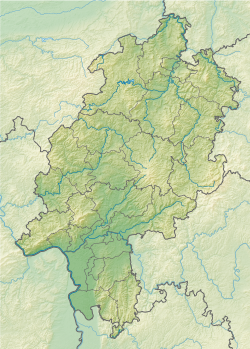
Back لرش ابی AZB Лоршскі кляштар Byelorussian Лорш (манастир) Bulgarian Abadia de Lorsch Catalan Opatství Lorsch Czech Lorsch Kloster Danish Kloster Lorsch German Αββαείο του Λορς Greek Monaĥejo Lorsch Esperanto Abadía de Lorsch Spanish
| UNESCO World Heritage Site | |
|---|---|
 The 9th-century Torhalle (gatehouse) is a unique survival of the Carolingian era. It curiously combines some elements of the Roman triumphal arch (arch-shaped passageways, half-columns) with the vernacular Teutonic heritage (baseless triangles of the blind arcade, polychromatic masonry). | |
| Location | Lorsch, Bergstraße, Hesse, Germany |
| Part of | Abbey and Altenmünster of Lorsch |
| Criteria | Cultural: (iii), (iv) |
| Reference | 515bis-001 |
| Inscription | 1991 (15th Session) |
| Area | 3.11 ha (7.7 acres) |
| Buffer zone | 14.825 ha (36.63 acres) |
| Website | www |
| Coordinates | 49°39′13″N 8°34′11″E / 49.65361°N 8.56972°E |
Lorsch Abbey, otherwise the Imperial Abbey of Lorsch (German: Reichsabtei Lorsch; Latin: Laureshamense Monasterium or Laurissa), is a former Imperial abbey in Lorsch, Germany, about 10 km (6.2 mi) east of Worms. It was one of the most important monasteries of the Carolingian Empire. Even in its ruined state, its remains are among the most important pre-Romanesque–Carolingian style buildings in Germany.[1]
Its chronicle, entered in the Lorscher Codex compiled in the 1170s (now in the state archive at Würzburg), is a fundamental document for early medieval German history. Another famous document from the monastic library is the Codex Aureus of Lorsch.
In 1991 the ruined abbey was listed as a UNESCO World Heritage Site because of its architectural and historical importance.[1] The significant remains visible today are the 9th-century Torhalle (gatehouse), part of the abbey church, some of the wall around the abbey, and other walls and parts of buildings adapted to modern use.
- ^ a b "Abbey and Altenmünster of Lorsch". UNESCO World Heritage Centre. United Nations Educational, Scientific, and Cultural Organization. Retrieved 18 Jun 2021.


